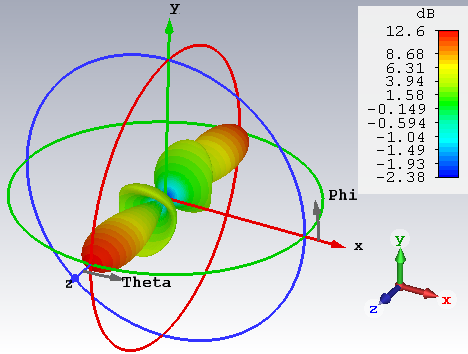Defining Effective Gain for Evaluation of Orbital Angular Momentum Links
DOI:
https://doi.org/10.46604/aiti.2021.6922Keywords:
circular array antenna, effective OAM gain, helical phase front, orbital angular momentum, OAM linkAbstract
In this paper, a communication link based on circular phased array antennas generating orbital angular momentum (OAM) beams at radio frequency is investigated. The presence of a null in the radiation pattern of OAM antennas is the main drawback of them. This problem makes it difficult to establish a telecommunication link using OAM systems and calculate the link budget for such a system. To solve this problem, we have defined two new gain parameters by using Friis Transmission Equation. The new formulas can help to calculate the effective gain of OAM antennas. Also, we have defined the effective OAM gain in detail for the first time in order to evaluate the performance of the OAM links. By using the proposed formulas, a capable and secure link based on the orthogonality of OAM beams can be designed.
References
Y. Yan, G. Xie, M. P. Lavery, H. Huang, N. Ahmed, C. Bao, et al., “High-Capacity Millimetre-Wave Communications With Orbital Angular Momentum Multiplexing,” Nature Communications, vol. 5, no. 1, pp. 1-9, September 2014.
N. Bozinovic, Y. Yue, Y. Ren, M. Tur, P. Kristensen, H. Huang, et al., “Terabit-Scale Orbital Angular Momentum Mode Division Multiplexing in Fibers,” Science, vol. 340, no. 6140, pp. 1545-1548, June 2013.
F. Tamburini, E. Mari, A. Sponselli, B. Thidé, A. Bianchini, and F. Romanato, “Encoding Many Channels on the Same Frequency through Radio Vorticity: First Experimental Test,” New Journal of Physics, vol. 14, no. 3, 033001, March 2012.
O. Edfors and A. J. Johansson, “Is Orbital Angular Momentum (OAM) Based Radio Communication an Unexploited Area?” IEEE Transactions on Antennas and Propagation, vol. 60, no. 2, pp. 1126-1131, February 2012.
M. Zyczkowski, K. D. Brewczynski, and M. Karol, “Innovative Security Technology for Optical Fiber Data Transmission Using Optical Vortex,” Proceedings of Engineering and Technology Innovation, vol. 5, no. 1, pp. 1-6, August 2017.
L. Allen, M. W. Beijersbergen, R. J. C. Spreeuw, and J. P. Woerdman, “Orbital Angular Momentum of Light and the Transformation of Laguerre-Gaussian Laser Modes,” Physical Review A, vol. 45, no. 11, pp. 8185-8189, June 1992.
M. W. Beijersbergen, R. P. C. Coerwinkel, M. Kristensen, and J. P. Woerdman, “Helical-Wavefront Laser Beams Produced with a Spiral Phaseplate,” Optics Communications, vol. 112, no. 5-6, pp. 321-327, December 1994.
S. M. Mohammadi, L. K. Daldorff, J. E. Bergman, R. L. Karlsson, B. Thidé, K. Forozesh, et al., “Orbital Angular Momentum in Radio—A System Study,” IEEE Transactions on Antennas and Propagation, vol. 58, no. 2, pp. 565-572, February 2010.
M. Veysi, C. Guclu, and F. Capolino, “Vortex Beams with Strong Longitudinally Polarized Magnetic Field and their Generation by Using Metasurfaces,” Journal of the Optical Society of America B, vol. 32, no. 2, pp. 345-354, February 2015.
M. S. Soskin, V. N. Gorshkov, M. V. Vasnetsov, J. T. Malos, and N. R. Heckenberg, “Topological Charge and Angular Momentum of Light Beams Carrying Optical Vortices,” Physical Review A, vol. 56, no. 5, pp. 4064-4075, November 1997.
J. Wang, J. Y. Yang, I. M. Fazal, N. Ahmed, Y. Yan, H. Huang, et al., “Terabit Free-Space Data Transmission Employing Orbital Angular Momentum Multiplexing,” Nature Photonics, vol. 6, no. 7, pp. 488-496, July 2012.
B. Thidé, H. Then, J. Sjöholm, K. Palmer, J. Bergman, T. D. Carozzi, et al., “Utilization of Photon Orbital Angular Momentum in the Low-Frequency Radio Domain,” Physical Review Letters, vol. 99, no. 8, 087701, August 2007.
D. Zelenchuk and V. Fusco, “Split-Ring FSS Spiral Phase Plate,” IEEE Antennas and Wireless Propagation Letters, vol. 12, pp. 284-287, 2013.
X. Hui, S. Zheng, Y. Chen, Y. Hu, X. Jin, H. Chi, et al., “Multiplexed Millimeter Wave Communication with Dual Orbital Angular Momentum (OAM) Mode Antennas,” Scientific Reports, vol. 5, no. 1, 10148, May 2015.
A. M. Yao and M. J. Padgett, “Orbital Angular Momentum: Origins, Behavior and Applications,” Advances in Optics and Photonics, vol. 3, no. 2, pp. 161-204, June 2011.
J. D. Jackson, “Classical Electrodynamics, 3rd ed.” American Journal of Physics, vol. 67, no. 9, 841, September 1999.
L. Josefsson and P. Persson, Conformal Array Antenna Theory and Design, 1st ed. Hoboken: John Wiley & Sons, Inc., 2006.
T. B. Vu, “Side-Lobe Control in Circular Ring Array,” IEEE Transactions on Antennas and Propagation, vol. 41, no. 8, pp. 1143-1145, August 1993.
C. A. Balanis, Antenna Theory: Analysis and Design, 4th ed. Hoboken: John Wiley & Sons, Inc., 2016.
A. F. Morabito, L. Di Donato, and T. Isernia, “Orbital Angular Momentum Antennas: Understanding Actual Possibilities through the Aperture Antennas Theory,” IEEE Antennas and Propagation Magazine, vol. 60, no. 2, pp. 59-67, April 2018.
D. K. Nguyen, O. Pascal, J. Sokoloff, A. Chabory, B. Palacin, and N. Capet, “Discussion about the Link Budget for Electromagnetic Wave with Orbital Angular Momentum,” The 8th European Conference on Antennas and Propagation, April 2014, pp. 1117-1121.
D. K. Nguyen, O. Pascal, J. Sokoloff, A. Chabory, B. Palacin, and N. Capet, “Antenna Gain and Link Budget for Waves Carrying Orbital Angular Momentum,” Radio Science, vol. 50, no. 11, pp. 1165-1175, November 2015.

Published
How to Cite
Issue
Section
License
Submission of a manuscript implies: that the work described has not been published before that it is not under consideration for publication elsewhere; that if and when the manuscript is accepted for publication. Authors can retain copyright in their articles with no restrictions. is accepted for publication. Authors can retain copyright of their article with no restrictions.
Since Jan. 01, 2019, AITI will publish new articles with Creative Commons Attribution Non-Commercial License, under The Creative Commons Attribution Non-Commercial 4.0 International (CC BY-NC 4.0) License.
The Creative Commons Attribution Non-Commercial (CC-BY-NC) License permits use, distribution and reproduction in any medium, provided the original work is properly cited and is not used for commercial purposes.







